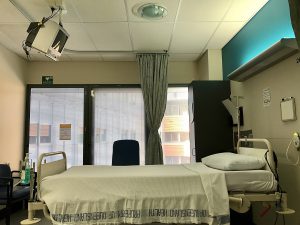
(h/t to Jonathan Eisen for the original article)
Virtually all the discussion these days is about aerosol/airborne transmission of SARS-CoV-2, and probably rightly so… there’s a lot of evidence that these are the primary routes of transmission. But as a recent Medscape article admonishes; “Don’t Forget the Fomites as Face-to-Face Care Ramps Up“. It’s still unclear what risk, if any, fomites play in the transmission of this coronavirus. It’s very hard to tease out since in most cases where aerosols are being deposited on surfaces that might present risk, people are also exposed to those same aerosols directly. As with everything, masks probably help because the reduce the deposition on surfaces as well as directly between people.
This article highlights a report from May called “Report into a nosocomial outbreak of coronavirus disease 2019 (COVID-19) at Netcare St. Augustine’s Hospital“. While this is not a published study, it’s a very detailed dive into this particular outbreak at a hospital in South Africa.
Of particular interest to me were the following couple of statements:
We present evidence that suggests there was a single introduction of SARS-CoV-2 into St. Augustine’s Hospital followed by widespread transmission to patients and health care workers…
And they do indeed present evidence that most of the people who got COVID-19 in outbreak, got it from the hospital.
As for fomites, here’s the conclusion of the study:
The spatial distribution of cases and exposed individuals who became infected on the wards suggests that the indirect contact via health care workers or fomite transmission were the predominant modes of transmission between patients in this outbreak.
I think this is an important reminder about how much we still don’t understand regarding the transmission dynamics of this virus and which activities/spaces present the most risk.
Except that the authors ignored air transmission a priori, so therefore didn’t do serious analysis to rule it out. In my mind, given the spatial extent, could have been just as plausible.
A totally fair point! I still think we shouldn’t rule out fomites as a potential transmission risk but it’s very hard to prove. Not many situations where fomites can be fingered as being responsible where there’s not some chance of air transmission as well.
Given this statement in the news piece (“Rather, it spread principally from hand-to-hand contact and from high-touch shared items of equipment, such as thermometers, blood pressure cuffs, and stethoscopes.”), I was interested to see how they showed this in the study. But, they didn’t. Instead, they just say it’s possible: “Transmission of SARS‐CoV‐2 can occur by direct contact with infected people and indirect contact with surfaces in the immediate environment or with objects used on the infected person (e.g. stethoscope or thermometer).”
I’ve heard many epi folks now downplaying fomite transmission (e.g. https://www.npr.org/transcripts/879255417); may be right, I’m just curious to see the data they are looking at.
I would love to see some proof one way or another… but fomite transmission seems like a really hard thing to prove or disprove outside of animal models.